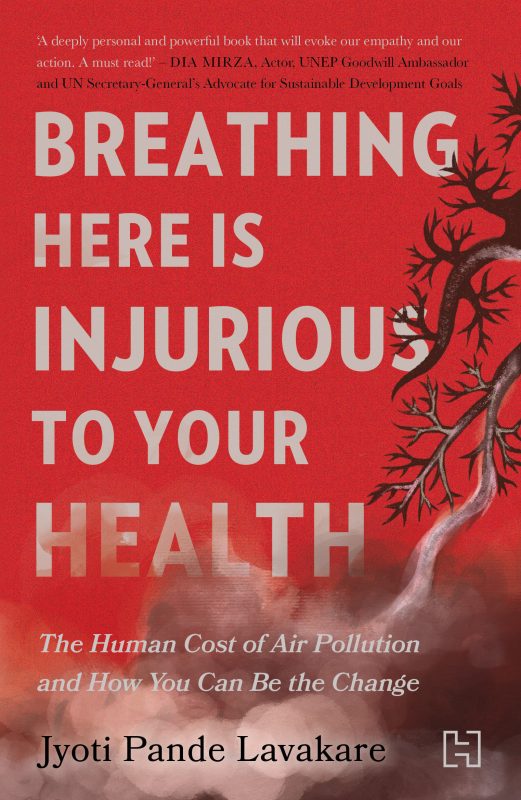Breathing Here Is Injurious To Your Health (Hachette India, 2020) is a compelling first person account of the struggle to bring India’s air pollution crisis to the forefront of the country’s policy priorities. Packed with information, this well-written book also bears witness to the appalling personal losses caused by the subcontinent’s poisoned air.

Particularly striking are the author’s descriptions of the many forms of denial that India’s air pollution activists have to deal with: assertions that ‘you’re over-reacting’, or that Indians have developed immunities to bad air, and so on. As Lavakare points out: ‘inhaling even small amounts of microparticles reduces immunity rather than building it. Simply put, inhaled microparticles cause inflammation and oxidative stress on every organ they touch, beginning with the lining of the nose all the way to the lining of the lungs and beyond, releasing free radicals and reducing overall immunity. Unlike immunity to bacteria and viruses, the build-up of particulate matter over the years probably explains reduced immunity, greater sickening, faster aging and many other symptoms. People confuse immunity with endurance.’
In recent years the world’s focus, so far as air pollution is concerned, has been on China, not India. In the mainstream media narrative, it was China that had the worst air quality problem in the world. Yet, the data shows that through much of this time New Delhi’s air quality was much worse than that of Beijing. Yet, India’s air pollution crisis was ignored, by the local media as well as by foreign journalists.
Why the disparity? Lavakare’s book suggests that there were two reasons for this. One was that there was much more public concern about pollution in China than in India. The second was that Western diplomats and journalists generally avoided talking about India’s air quality even though they knew very well how bad the situation was. The reasons for this are not hard to discern; they are the same as those that shield India from international criticism on many other counts as well. It is because India serves as a convenient ideological counterweight to China, as a different model of development. In effect, it was for ideological and strategic reasons that India’s air pollution problem was long overlooked, at immense cost to ordinary Indians. The silence was not broken until the New York Times’s South Asia correspondent, Gardiner Harris, began to write about the subject in 2014.
The rise to dominance of neo-liberal ideologies also has much to do with India’s failure to confront the pollution crisis. Lavakare is by no means a critic of neoliberalism, but her book provides a telling example of its effects. Over the last decade, vast clouds of smoke have been descending on the region around New Delhi in late October, making the area’s already catastrophic air quality even worse. This annual plague of smoke is caused by the burning of crop stubble, by farmers. Lavakare quotes the journalist Arvind Kumar, who has traced the problem back to a series of decisions taken by the government of Punjab, between 2007 and 2009, when a law was passed that effectively forced farmers to change their patterns of cropping such that they were left with a very small window between the harvesting of one crop and the planting of the next. Hence the hurry to burn the remnants of a harvested crop, in October – at exactly the time when the prevailing winds carry the smoke in the direction of New Delhi and its environs, which are home to 46 million people.
But there is a further twist to the story: the primary beneficiary of the change in cropping patterns is none other than the mega-corporation Monsanto, which has long sought to control the world’s supply of food. ‘The push for Punjab’s law came from another source,’ writes Arvind Kumar, ‘the United States Agency for International Development (USAID), which has acted as a shill for Monsanto around the world.’ Kumar’s conclusion is that ‘the people of Delhi have two choices. They could either take to the streets and march against Monsanto and evict the corporation from India and restore the previous cropping pattern, or they can wait to get suffocated when Delhi once again becomes a gas chamber this year.’
Indeed, it is increasingly clear that post-war American policy interventions in India, such as its advocacy of the ‘Green Revolution’ have been largely responsible for creating the compounding environmental disasters that underlie the currently ongoing farmers’ protests. These protests are said to be the largest in human history, yet the government of Prime Minister Narendra Modi remains unmoved in its determination to impose a set of laws that will benefit mega-corporations that are close to his party.
India’s failure to adequately address its air pollution problem is a grim portent for the future: it suggests that the country will be similarly unable to deal with other aspects of the intensifying planetary crisis, such as climate change. It is perfectly clear now that India’s government, and its political class, have been captured by corporate interests to such a degree that they have become incapable of acting in the public interest.
Amitav Ghosh
January 27, 2021
